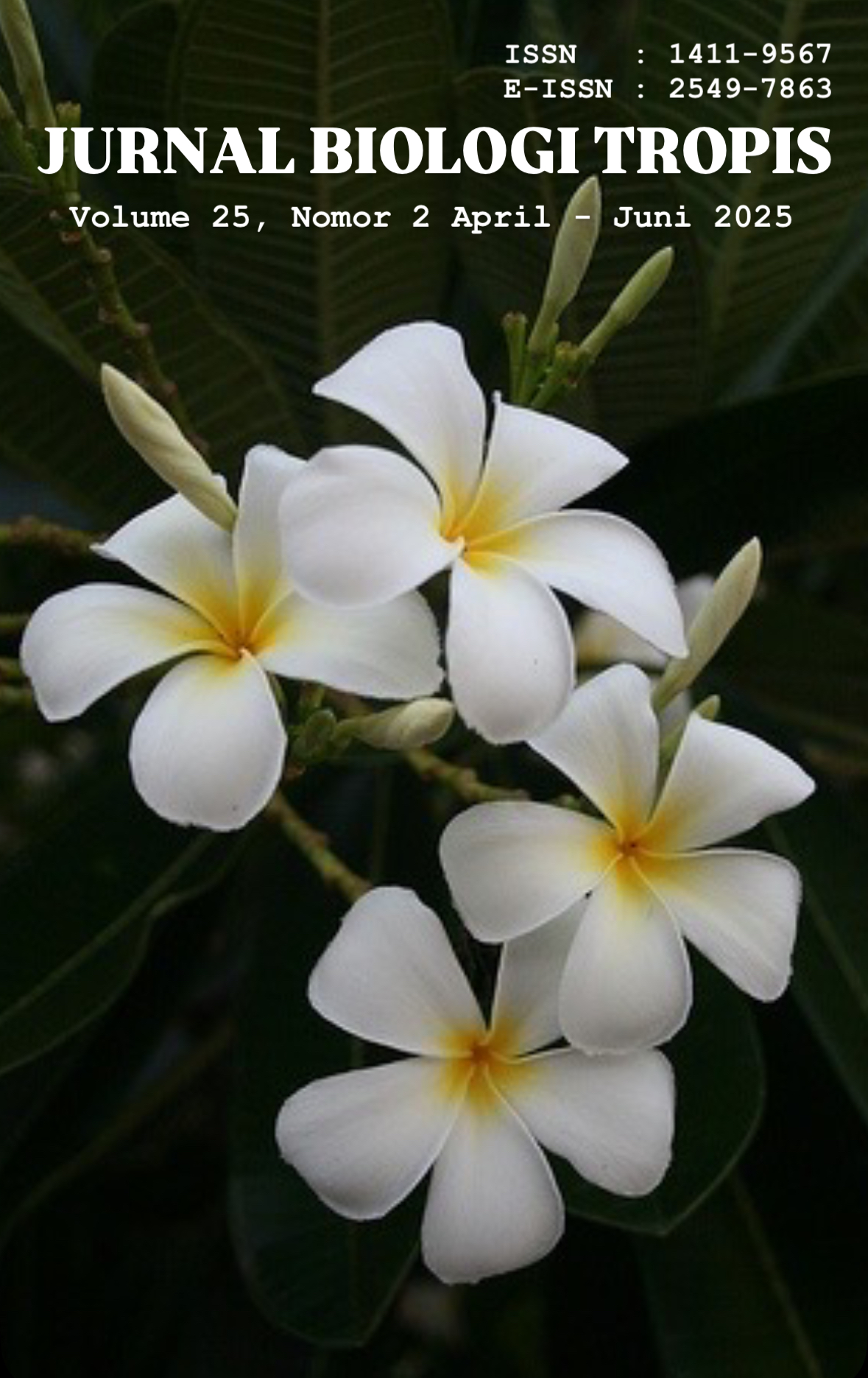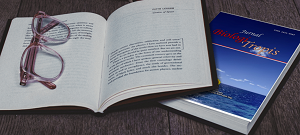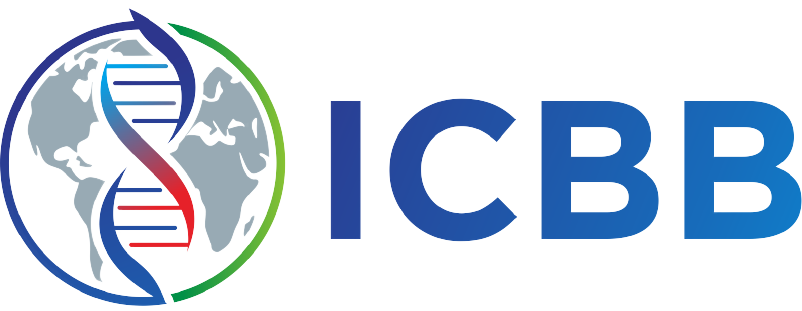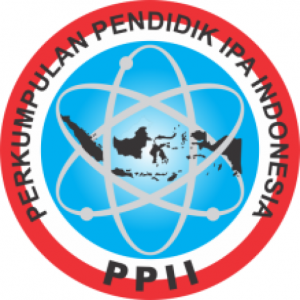Hydrolysed Fish Peptide, Turmeric and Garlic Powder Supplementation to Reducing Vibrio Bacteria in Litopenaeus vannamei
Authors
Lilik Setiyaningsih , Ren Fitriadi , Baruna Kusuma , Jefri Anjaini , Purnama SukardiDOI:
10.29303/jbt.v25i2.8958Published:
2025-05-22Issue:
Vol. 25 No. 2 (2025): April-JuniKeywords:
Fish peptide hydrolysis, garlic, immunostimulant, Litopenaeus vannamei, turmeric, vibriosis.Articles
Downloads
How to Cite
Downloads
Metrics
Abstract
Vibriosis disease caused by Vibrio bacteria is one of the main challenges in vaname shrimp (Litopenaeus vannamei) farming, as it can cause high mortality rates and decreased productivity. This study aims to evaluate the effectiveness of a combination of natural immunostimulants in turmeric (Curcuma longa) and garlic (Allium sativum) combined with hydrolysis of fish peptides in suppressing Vibrio spp. bacterial populations in the hepatopancreas organs. The study was conducted for 30 days using a completely randomised design of four treatments and three replications. Treatment A (feed+turmeric75%+garlic25%+fish peptide hydrolysis2%), Treatment B (feed+turmeric50%+garlic50%+fish peptide hydrolysis2%), Treatment C (feed+turmeric25%+garlic75%+fish peptide hydrolysis2%), and Treatment K (feed without immunostimulant and fish peptide hydrolysis). Total Vibrio spp. bacteria were counted using the total plate count method on the hepatopancreas organ of the shrimp. The results showed that the immunostimulant combination of turmeric 75%, garlic 25%, and fish peptide hydrolysis 2% (treatment A) significantly reduced the total number of Vibrio spp. bacteria in the hepatopancreas to 2.45 ± 0.213 log CFU/ml compared to the control. The combination of turmeric and garlic immunostimulants and fish peptide hydrolysis has the potential to be an effective natural strategy in controlling vibriosis disease in shrimp farming.
References
Abdelwahab AM., El-Bahr SM. & Al-Khamees S. (2020). Influence of Dietary Garlic (Allium sativum) and/or Ascorbic Acid on Performance, Feed Utilization, Body Composition and Hemato-Biochemical Parameters of Juvenile Asian Sea Bass (Lates calcarifer). Animals, 10(12): 2396. https://doi.org/10.3390/ani10122396
Abdulaziz A., Pramodh AV., Sukumaran V., Raj D. & John AM. (2023). The Influence of Photodynamic Antimicrobial Chemotherapy on the Microbiome, Neuroendocrine and Immune System of Crustacean Post Larvae. Toxics, 11(1):36. https://doi.org/10.3390/toxics11010036
Abdullah FI., Hamid NH., Karim MM., Ismail MF., Leena N., Sin WW. & Kamarudin MS. (2024). Fish Protein Hydrolysate for Fish Health. Biocatalysis and Agricultural Biotechnology, 60:2024. https://doi.org/10.1016/j.bcab.2024.103292
Adineh H., Harsij M., Jafaryan H. & Asadi M. (2020). The Effects of Microencapsulated Garlic (Allium Sativum) Extract on Growth Performance, Body Composition, Immune Response and Antioxidant Status of Rainbow Trout (Oncorhynchus Mykiss) Juveniles. Journal of Applied Animal Research, 48(1): 372-378. https://doi.org/10.1080/09712119.2020.1808473
Aly S., Elatta M., Nasr A. & Fathi M. (2023). Efficacy of Garlic and Cinnamon as An Alternative to Chemotherapeutic Agents In Controlling Saprolegnia Infection In Nile Tilapia. Aquaculture & Fisheries, 10(1): 105-114. https://doi.org/10.1016/j.aaf.2023.07.010
Amer S., El-Araby DA., Tartor H., Farahat M., Goda N., Farag M., Fahmy EM. & Hassan AM. (2022). Long-Term Feeding with Curcumin Affects the Growth, Antioxidant Capacity, Immune Status, Tissue Histoarchitecture, Immune Expression of Proinflammatory Cytokines, and Apoptosis Indicators in Nile Tilapia, Oreochromis niloticus. Antioxidants, 11(5):937. https://doi.org/10.3390/antiox11050937
Aminzare M., Hashemi M., Abbasi Z., Mohseni M. & Amiri E. (2018). Vibriosis phytotherapy: A Review on the Most Important World Medicinal Plants Effective on Vibrio spp. Journal of Applied Pharmaceutical Science, 8(1):170-177. https://10.7324/JAPS.2018. 8126
Ansar NM., Ijong FG., Tanod WA., Cahyono E., Pumpente. & Palawe JF. (2023). Growth Characteristics of Vibrio parahaemolyticus Isolated from Lobster (Panulirus sp.) Under Different Temperatures, pH, and NaCl Concentration. Bioma, 25(1):74-87. https://doi.org/10.14710/bioma.25.1.74-87
Aulia R., Ernah E. & Mubarok S. (2021). Utilization Of Active Compounds in Tumeric (Curcuma Longa) As Antioxidant Herbal. AGROLAND The Agricultural Sciences Journal (e-Journal), 8(1): 2407-7593. https://doi.org/10.22487/AGROLAND.V0I0.630
Balci BA., Aktop Y., Arslan MN., Unver A.C, Ozbas M. & Kilic H. (2024). Effect of Growth Performance and Survival Rate of Goldfish (Carassius auratus L. 1758) Fed Garlic (Allium sativum L.) Supplemented Diets. Journal of the Hellenic Veterinary Medical Society, 75(2):2024. https://doi.org/10.12681/jhvms.34541
Bhatwalkar SB., Mondal R., Krishna S., Adam J., Govender P. & Anupam R. (2021). Antibacterial Properties of Organosulfur Compounds of Garlic (Allium sativum). Frontiers in Microbiology, 12:2021. https://doi.org/10.3389/fmicb.2021.613077
Borlinghaus J., Foerster J., Kappler U., Antelmann H., Noll U., Gruhlke M. & Slusarenko A. (2021). Allicin, the Odor of Freshly Crushed Garlic: A Review of Recent Progress in Understanding Allicin’s Effects on Cells. Molecules, 26(6):1505. https://doi.org/10.3390/molecules26061505
Chavan H., Borate A., Chaure S. & Muley SS. (2020). General Overview on Immunomodulator Activity of Herbal Natural Products. World Journal of Pharmaceutical Research, 9(9): 172-188. https://wjpr.net/abstract_show/15108
Choo S., Chin V., Wong EH., Maldhavan P., Tay S., Yong P. & Chong P. (2020). Review: Antimicrobial Properties of Allicin Used Alone or In Combination with Other Medications. Folia Microbiologica (Prague), 65:451-465. https://doi.org/10.1007/s12223-020-00786-5
Dai C., Lin J., Shen Z., Wang Y., Velkov T. & Shen J. (2022). The Natural Product Curcumin as an Antibacterial Agent: Current Achievements and Problems. Antioxidants, 11(3). https://doi.org/10.3390/antiox11030459
Delgado D., Careces LL., Gomez SA. & Odio A. (2023). Effect of Dietary Garlic (Allium sativum) on the Zootechnical Performance and Health Indicators of Aquatic Animals: A mini-review. Veterinary World, 16(5): 965-976. https://doi.org/10.14202/vetworld.2023.965-976
Denji KA., Soltani M., Islami HR. & Kamali A. (2020). The antifungal effects of Allium sativum and Artemisia sieberi Extracts on Hatching Rate and Survival of Rainbow Trout Oncorhynchus mykiss (Walbaum, 1792) Larvae. Iranian Journal of Fisheries Sciences, 19(2): 669-680. https://doi.org/10.22092/ijfs.2019.119128.0
Eissa EH., Ezzo OH., Khalil HS., Tawfik WA., El-Badawi A., Elghany NA., Mossa M., Hassan MM., Hassan MF., Shafi M. & Hamouda A. (2022). The Effect of Dietary Nanocurcumin on the Growth Performance, Body Composition, Haemato‐Biochemical Parameters and Histopathological Scores of The Nile Tilapia (Oreochromis Niloticus) Challenged with Aspergillus Flavus. Aquaculture Research, 15(17):6098-6111. https://doi.org/10.1111/are.16084
El-bab AF., El-Ratel IT., Abdel-Warith AA., Younis EM., Davies SJ. & El-Raghi AA. (2024). Investigating The Impact of Nanoemulsion of Curcumin-Loaded Olive Oil on Growth Performance, Feed Utilization, Immunological Responses, And Redox Status of Litopenaeus Vannamei Shrimp with Emphasis on Economic Efficiency of Supplementation. Journal of Animal Physiology and Animal Nutrition, 108(6): 1877-1889. https://doi.org/10.1111/jpn.14027
Gabriel T., Vestine A., Kim KD., Kwon S.J, Sivanesan I. & Chun SC. (2022). Antibacterial Activity of Nanoparticles of Garlic (Allium sativum) Extract against Different Bacteria Such as Streptococcus mutans and Poryphormonas gingivalis. Applied Sciences, 12(7): 3491. https://doi.org/10.3390/app12073491
Gan L., Zheng J., Xu WH., Lin J., Liu J., Zhang Y., Wu Z., Lv Z., Jia Y., Guo Q., Chen S., Liu C., Defoirdt T., Qin Q. & Liu Y. (2022). Deciphering the Virulent Vibrio harveyi Causing Spoilage in Muscle of Aquatic Crustacean Litopenaeus vannamei. Scientific Reports, 12(16296):1-10. https://www.nature.com/articles/s41598-022-20565-1
Garcia-Perez OD., Tapia-Salazar M., Nieto-Lopez MG., Cruz-Valdez JC., Maldonado-Muniz M., Guerrero LM., Cruz-Suarez L. & Marroquin-Cardona A. (2020). Effects of Conjugated Linoleic Acid and Curcumin on Growth Performance and Oxidative Stress Enzymes in Juvenile Pacific White Shrimp (Litopenaeus Vannamei) Feed with Aflatoxins. Aquaculture Research, 15(3):1051-1060. https://doi.org/10.1111/are.14451
Ghosh AK., Panda SK. & Luyten W. (2021). Antivibrio and Immune-Enhanching Actovity of Medicinal Plants in Shrimph: a comprehensive review. Fish and Shellfish Immunology, 2021;117:192-210. https://doi.org/10.1016/j.fsi.2021.08.006
Gutierrez RV., Lestón AL., Albores FV., Cicala F. & Porchas MM. (2021). Exploring the Garlic (Allium sativum) Properties for Fsh Aquaculture. Fish Physiol Biochem, 47(4): 1179–1198. https://doi.org/10.1007/s10695-021-00952-7
Haryani WHO., Samanah MAA., Sayuti MA., Chin YK., Saad MZ., Natrah I., Aman MNA., Satyantini WH. & Salwani MYI. (2018). Prevalence, Antibiotics Resistance and Plasmid Profiling of Vibrio spp. Isolated from Cultured Shrimp in Peninsular Malaysia. Microorganisms,10(9): 1851. https://doi.org/10.3390/microorganisms10091851
Hoseinifar S., Dadar M. & Ringo E. (2017). Modulation of Nutrient Digestibility and Digestive Enzyme Activities in Aquatic Animals: The Functional Feed Additives Scenario. Aquaculture Research, 48(8): 3987-4000. https://doi.org/10.1111/ARE.13368
Hou Y., Wu Z., Dai Z., Wang G. & Wu G. (2017). Protein Hydrolysates in Animal Nutrition: Industrial Production, Bioactive Peptides, and Functional Significance. Journal of Animal Science and Biotechnology, 8(24):1-13. https://doi.org/10.1186/s40104-017-0153-9
Hou Y., Wu Z., Dai Z., Wang G. & Wu G. (2022). Protein Hydrolysates in Animal Nutrition. Bioactive Peptides from Food, https://doi.org/10.1201/9781003106524-14
Hussain Y., Alam W., Ullah H., Dacrema M., Daglia W., Khan H. & Arciola CR. (2022). Antimicrobial Potential of Curcumin: Therapeutic Potential and Challenges to Clinical Applications. Antibiotics, 11(3):322. https://doi.org/10.3390/antibiotics11030322
Ibrahim WNW., Leong LK., Razzak LA., Musa N., Daniel WD. & Zainathan SC. (2021). Virulence Properties and Pathogenicity Of Multidrug-Resistant Vibrio harveyi Associated with Luminescent Vibriosis in Pacific White Shrimp, Penaeus vannamei. Journal Pre-proof. 2021; 186:1-47. https://doi.org/10.1016/j.jip.2021.107594
Jahanbakhishi A., Pourmozaffar S., Adeshina I., Vayghan AH. & Reverter M. (2022). Effect of garlic (Allium sativum) Extract on Growth, Enzymological and Biochemical Responses and Immune-Related Gene Expressions in Giant Freshwater Prawn (Macrobrachium Rosenbergii). Journal of Animal Physiology and Animal Nutrition, 106(4): 947-956. https://doi.org/10.1111/jpn.13718
Jahanjoo V., Yahyavi M., Akrami R. and & Bahri AH. (2018). Influence of Adding Garlic (Allium sativum), Ginger (Zingiber officinale), Thyme (Thymus vulgaris) and Their Combination on the Growth Performance, Haemato Immunological Parameters and Disease Resistance to Photobacterium damselae in Sobaity Sea Bream (Sparidentex hasta) Fry. Turkish Journal of Fisheries and Aquatic Sciences, 18: 633-645. https://doi.org/10.4194/1303-2712-v18_4_15.
Jennings M. & Parks R. (2020). Curcumin as an Antiviral Agent. Viruses, 12(11):1-15. https://doi.org/10.3390/v12111242
Khieokhajonkhet A., Roatboonsongsri T., Suwannalers P., Aeksiri N., Kaneko G., Ratanasut K. & Inyawilert. (2023). Effects Of Dietary Supplementation of Turmeric (Curcuma Longa) Extract on Growth, Feed and Nutrient Utilization, Coloration, Hematology, And Expression of Genes Related Immune Response in Goldfish (Carassius auratus). Aquaculture Reports, 32: 101705. https://doi.org/10.1016/j.aqrep.2023.101705
Kumar V., Roy S., Behera BK., Bossier P. & Das BK. (2021). Acute Hepatopancreatic Necrosis Disease (AHPND): Virulence, Pathogenesis and Mitigation Strategies in Shrimp Aquaculture. Toxin, 13(8):524. https://doi.org/10.3390/toxins13080524
Lee JS., Damte D., Lee SJ., Hossain MA., Belew S., Kim JY., Rhee MH., Kim JC. & Park SC. (2014). Evaluation and Characterization of a Novel Probiotic Lactobacillus pentosus PL11 Isolated from Japanese Eel (Anguilla japonica) for its use in Aquaculture. Aquaculture Nutrition. https://doi.org/10.1111/anu.12176
Leimann F., Moreira TF., Goncalves OH. & Ribeiro R. (2023). Fish Protein Hydrolysates: Bioactive Properties, Encapsulation and New Technologies for Enhancing Peptides Bioavailability. Current pharmaceutical design, 29(11):824-836. https://doi.org/10.2174/1381612829666230110141811
Lorenz E., Sabioni R., Volkoff H. & Cyrino J. (2021). Growth Performance, Health, And Gene Expression of Appetite-Regulating Hormones in Dourado Salminus Brasiliensis, Fed Vegetable-Based Diets Supplemented with Swine Liver Hydrolysate. Aquaculture, 548(2). https://doi.org/10.1016/j.aquaculture.2021.737640
Martins VG., Nascimento JD., Martins FM. & Vigoder HC. (2022). Vibriosis and Its Impact on Microbiological Food Safety. Food Science and Technology, 42:2022. https://doi.org/10.1590/fst.65321
Munir Z., Banche G., Cavallo L., Mandras N., Roana J., Pertusio R., Ficiara E., Cavali R. & Guiot C. (2022). Exploitation of the Antibacterial Properties of Photoactivated Curcumin as ‘Green’ Tool for Food Preservation. International Journal of Molecular Sciences, 23(5):2600. https://doi.org/10.3390/ijms23052600
Nath A., Chatterjee P., Chowdhury S., Ray N. & Mukherjee S. (2021). Antimicrobial activity of turmeric (Curcuma longa) extract and its potential. Indian Journal of Animal Health, 60(2):109-118. DOI: https://doi.org/10.36062/ijah.2021.spl.02121
Nazzaro F., Polito F., Amato G., Caputo L., Francolino R., Dacierno A., Fratianni F., Candido V., Coppola R. & Feo VD. (2022). Chemical Composition of Essential Oils of Bulbs and Aerial Parts of Two Cultivars of Allium sativum and Their Antibiofilm Activity against Food and Nosocomial Pathogens.Antibiotics, 11(6):1-13. https://doi.org/10.3390/antibiotics11060724
Ngasotter S., Mukherjee S., Singh SK., Bharti D., Haque R., Varshney S., Nanda C., Waikhom., Devi MS. & Singh AS. (2022). Prevalence, Virulence and Antibiotic Resistance Profiles of Vibrio parahaemolyticus from Seafood and its Environment: An Updated Review. Mediterranean Journal of Infection, Microbes and Antimicrobials, 11(1). https://doi.org/10.4274/mjima.galenos.2021.2021.1
Ngerson S. (2022). In vitr In vitro inhibit o inhibitory effects of turmeric extr ects of turmeric extracts against biofilm acts against biofilm formation and virulence of flavobacterium oreochromis. Chula Digital Collections, https://doi.org/10.58837/CHULA.THE.2022.375
Nguyen TTL., Luu TTH., Nguyen TT., Pham VD., Nguyen TN., Truong QP. & Hong MH. (2023). A Comprehensive Study in Efficacy of Vietnamese Herbal Extracts on Whiteleg Shrimp (Penaeus vannamei) Against Vibrio parahaemolyticus Causing Acute Hepatopancreatic Necrosis Disease (AHPND). Israeli Journal of Aquaculture, 75(2):1-16. https://doi.org/10.46989/001c.81912
Ortizo RG., Sharma V., Tsai M., Wang J., Sun P., Nargotra P., Kuo C., Chen C. & Dong C. (2023). Extraction of Novel Bioactive Peptides from Fish Protein Hydrolysates by Enzymatic Reactions. Applied Sciences, 13(9): 5768. https://doi.org/10.3390/app13095768
Oz M. dan Dikel S. (2022). Effect of garlic (Allium sativum) - Supplemented Diet on Growth Performance, Body Composition and Fatty Acid Profile of Rainbow Trout (Oncorhynchus mykiss). Cellular and Molecular Biology, 68(1). https://doi.org/10.14715/cmb/2022.68.1.26
Pan S., Yan J., Xu X., Chen Y., Chen X., Li F. & Xing H. (2022). Current Development and Future Application Prospects of Plants-Derived Polyphenol Bioactive Substance Curcumin as a Novel Feed Additive in Livestock and Poultry. International Journal of Molecular Sciences, 23(19):11905. https://doi.org/10.3390/ijms231911905
Poulin S., Ahmadifar E., Deepak C., Morteza Y., Sevdan Y., Yilmaz E., Sheikhzades N., Harikrishnan R. & Latif H. (2024). The anti-vibrio Potential of Medicinal Plants and Their Roles in Enhancing Resistance Against Vibrio Infections in Fish –A Mini Review. Annals of Animal Science, 25(2):405-415. https://doi.org/10.2478/aoas-2024-0067
Santana TM., Dantas FM., Santos DK., Kojima JT., Pastrana YM., Jesus RS. & Goncalves LU. (2023). Fish Viscera Silage: Production, Characterization, and Digestibility of Nutrients and Energy for Tambaqui Juveniles. Fishes, 8(2):111. https://doi.org/10.3390/fishes8020111
Saptiani G., Sidik AS. & Hardi EH. (2020). Response of Hemocytes Profile in the Black Tiger Shrimp (Penaeus monodon) against Vibrio harveyi Induced by Xylocarpus granatum Leaves Extract. Veterinary World.13(4):751-757. doi: www.doi.org/10.14202/vetworld.2020.751-757
Saputra A., Maftuch., andayani S. & Yanuhar U. (2023). Pathogenicity of Vibrio Parahaemolyticus Causing Acute Hepatopancreatic Necrosis Disease (AHPND) in shrimp (Litopanaeus vannamei) in Serang, Banten, Indonesia. Biodiversitas, 24(4):2365-2373. DOI https://doi.org/10.13057/biodiv/d240451
Sarjito, Haditomo AHC., Desrina., Djunaedi A. & Prayitno SB. (2018). The Diversity of Vibrios Associated with Vibriosis in Pacific White Shrimp (Litopenaeus vannamei) from Extensive Shrimp Pond in Kendal District, Indonesia. IOP Conf. Series: Earth and Environmental Science, 116:1-7. https://doi.org/10.1088/1755-1315/116/1/012011
Satgurunathan T., Bhavan PS. & Manjunath M. (2023). Influence of Garlic (Allium sativum) Clove-Based Selenium Nanoparticles on Status of Nutritional, Biochemical, Enzymological, and Gene Expressions in the Freshwater Prawn Macrobrachium rosenbergii (De Man, 1879). Biological Trace Element research, 201:2036-2057. https://doi.org/10.1007/s12011-022-03300-9
Siddik M., Howieson J., Fotedar R. & Partridge G. (2020). Enzymatic Fish Protein Hydrolysates in Finfish Aquaculture: a review. Reviews in Aquaculture, 13(1): 406-430. https://doi.org/10.1111/raq.12481
Sutili F., Gatlin D., Heinzmann B. & Baldisseroto B. (2018). Plant Essential Oils as Fish Diet Additives: Benefits On Fish Health and Stability in Feed. Reviews in Aquaculture, 10(3): 716-726. https://doi.org/10.1111/RAQ.12197
Valente DS. & Wan, A. (2021). Vibrio And Major Commercially Important Vibriosis Diseases in Decapod Crustaceans. Journal of Invertebrate Pathology, 181 (2021). https://doi.org/10.1016/j.jip.2020.107527
Valenzuela-Gutierrez R, Lago-Leston A. (2021). Exploring The Garlic (Allium Sativum) Properties for Fish Aquaculture. Fish Physiology and Biochemistry, 47:1179–1198. https://doi.org/10.1007/s10695-021-00952-7
Wahjuningrum D, Effendi I, Miranti S, Umam K, Abdullah T. (2024). Control Of Vibriosis By Using Turmeric-Kalmegh Extract with Different Period Treatments in Whiteleg Shrimp in the Floating Net-Cages. Indonesian Aquaculture Journal, 19(2):157-165. DOI: http://dx.doi.org/10.15578/iaj.19.2.2024.157-165
Xie J., Bu L., Jin S., Wang X., Zhao Q., Zhou S. & Xu Y. (2020). Outbreak Of Vibriosis Caused by Vibrio Harveyi and Vibrio Alginolyticus in Farmed Seahorse Hippocampus Kuda in China. Aquaculture, 523. https://doi.org/10.1016/j.aquaculture.2020.735168
Yang J., Hong J., Fu Z. & Ma Z. (2022). Effects of Dietary Curcumin on Growth and Digestive Physiology of Seriola dumerili. Frontiers in Marine Science, 9:2022. https://doi.org/10.3389/fmars.2022.862379
Zare M., Tran HQ., Prokesova M. & Stejskal V. (2021). Effects of Garlic Allium sativum Powder on Nutrient Digestibility, Haematology, and Immune and Stress Responses in Eurasian Perch Perca fluviatilis Juveniles. Animals, 11(9): 2735. https://doi.org/10.3390/ani11092735
Zhao Y., Zhou X., Wang FH., Muurinen J., Virta MP., Brandt KK. & Zhu YG. (2021). Antibiotic Resistome in The Livestock and Aquaculture Industries: Status and solutions. Critical Reviews in Environmental Science and Technology, 51(19):2159-2196. https://doi.org/10.1080/10643389.2020.1777815
Zhu F. (2020). A Review on the Application of Herbal Medicines in the Disease Control of Aquatic Animals. Aquaculture. 2020;526:1-7. https://doi.org/10.1016/j.aquaculture.2020.735422
Zou W., Ma Y., Yu W., Gao X., Liu ST., Luo X. & You W. (2022). Dietary Curcumin Influence on Growth, Antioxidant Status, Immunity, Gut Flora and Resistance to Vibrio Harveyi AP37 in Haliotis Discus Hannai. Aquaculture Reports, 26. https://doi.org/10.1016/j.aqrep.2022.101336
License
Copyright (c) 2025 Lilik Setiyaningsih, Ren Fitriadi, Baruna Kusuma, Jefri Anjaini, Purnama Sukardi

This work is licensed under a Creative Commons Attribution 4.0 International License.

Jurnal Biologi Tropis is licensed under a Creative Commons Attribution 4.0 International License.
The copyright of the received article shall be assigned to the author as the owner of the paper. The intended copyright includes the right to publish the article in various forms (including reprints). The journal maintains the publishing rights to the published articles.
Authors are permitted to disseminate published articles by sharing the link/DOI of the article at the journal. Authors are allowed to use their articles for any legal purposes deemed necessary without written permission from the journal with an acknowledgment of initial publication to this journal.


























